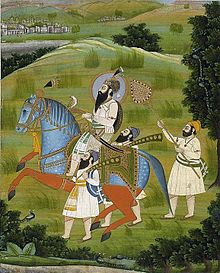Gobind Singh
| Guru Gobind Singh ਗੁਰੂ ਗੋਬਿੰਦ ਸਿੰਘ |
|
|---|---|

|
|
| Born |
Gobind Rai 22 December 1666 Patna Sahib (Present day India) |
| Died | 7 October 1708 (aged 41) Hazur Sahib Nanded (Present day India) |
| Other names | Tenth Nanak |
| Known for | Founding the Khalsa Wrote Jaap Sahib, Chandi di Var, Tav-Prasad Savaiye, Zafarnamah, Bachittar Natak, Akal Ustat, Chaupai (Sikhism) |
| Predecessor | Guru Tegh Bahadur |
| Successor | Guru Granth Sahib |
| Spouse(s) | Mata Jito, Mata Sundari and Mata Sahib Devan |
| Children |
Ajit Singh Jujhar Singh Zorawar Singh Fateh Singh |
| Parent(s) | Guru Tegh Bahadur, Mata Gujri |
Guru Gobind Singh, born Gobind Rai (22 December 1666 – 7 October 1708), was the 10th Sikh Guru, a spiritual master, warrior, poet and philosopher. When his father, Guru Tegh Bahadur, was beheaded for refusing to convert to Islam, Guru Gobind Singh was formally installed as the leader of the Sikhs at age nine, becoming the last of the living Sikh Gurus. His four sons died during his lifetime in Mughal-Sikh wars – two in battle, two executed by the Mughal army.
Among his notable contributions to Sikhism are founding the Sikh warrior community called Khalsa in 1699 and introducing the Five Ks, the five articles of faith that Khalsa Sikhs wear at all times. Guru Gobind Singh also continued the formalisation of the religion, wrote important Sikh texts, and enshrined the scripture the Guru Granth Sahib as Sikhism's eternal Guru.
Gobind Singh was the only son of Guru Tegh Bahadur, the ninth Sikh guru, and Mata Gujri. He was born in Patna (Bihar), while his father was visiting Bengal and Assam. His birth name was Gobind Rai, and a shrine named Takht Sri Patna Harimandar Sahib marks the site of the house where he was born and spent the first four years of his life. In 1670, his family returned to Punjab, and in March 1672 they moved to Chakk Nanaki in the Himalayan foothills of north India, called the Sivalik range, where he was schooled. Gobind Singh's father Tegh Bahadur founded the city of Chakk Nanaki, now known as Anandpur Sahib, in 1665, on land purchased from the ruler of Bilaspur (Kahlur).
...
Wikipedia
